NAD-Driven Sirtuin Activation by Cordyceps sinensis Extract: Exploring the Adaptogenic Potential to Promote Skin Longevity
Abstract
:1. Introduction
2. Results
2.1. C. sinensis Extract Preparation and Chemical Characterization
2.2. Biological Activity Determination
2.2.1. Effect of CsEx on Cellular Longevity
2.2.2. Effect of CsEx on ATP Production In Vitro and Boosting Skin Energy In Vivo
2.2.3. Effect of CsEx on Antioxidant Activity
2.2.4. Effect of CsEx on Collagen Production
2.2.5. Effect of CsEx on Wrinkle Appearance Reduction
3. Discussion
4. Materials and Methods
4.1. Reagents and Human Cell Cultures
4.2. Cordyceps sinensis Preparation and Extraction of Cordycepin Fraction
4.3. Identification and Quantification of the Cordycepin and Adenosine
4.4. CsEx Bioactive Metabolite Content Analysis
4.5. Sirtuin Expression Assay
4.6. NAD/NADH Ratio Assay
4.7. ATP Production Assay
4.8. Cytosolic ROS Assay
4.9. Collagen Production Assay
4.10. Statistical Analysis in Pre-Clinical Studies
4.11. CsEx-Based Topical Formulation Preparation
Quality Control and Potting of the Cosmetic Formulations
4.12. Clinical Study
4.12.1. Study Design and Participants
- Group 1: topical formula containing 6 mg/L CsEx;
- Group 2: placebo.
4.12.2. Randomization and Masking
4.12.3. Local Energy Balance Assessment
4.12.4. Anti-Aging Efficacy Assessment
4.12.5. Skin Tolerability Test
4.13. Statistical Analysis in Clinical Trial
5. Conclusions
Supplementary Materials
Author Contributions
Funding
Institutional Review Board Statement
Informed Consent Statement
Data Availability Statement
Acknowledgments
Conflicts of Interest
References
- Guo, J.; Huang, X.; Dou, L.; Yan, M.; Shen, T.; Tang, W.; Li, J. Aging and Aging-Related Diseases: From Molecular Mechanisms to Interventions and Treatments. Signal Transduct. Target. Ther. 2022, 7, 391. [Google Scholar] [CrossRef] [PubMed]
- Cong, W.; Chen, K. Traditional Chinese Medicine and Aging: Integration and Collaboration Promotes Healthy Aging. Aging Med. 2019, 2, 139–141. [Google Scholar] [CrossRef]
- Marshall, A.C. Traditional Chinese Medicine and Clinical Pharmacology. In Drug Discovery and Evaluation: Methods in Clinical Pharmacology, 2nd ed.; Springer International Publishing: New York, NY, USA, 2020; pp. 455–482. ISBN 9783319688640. [Google Scholar]
- Dhalaria, R.; Verma, R.; Kumar, D.; Puri, S.; Tapwal, A.; Kumar, V.; Nepovimova, E.; Kuca, K. Bioactive Compounds of Edible Fruits with Their Anti-Aging Properties: A Comprehensive Review to Prolong Human Life. Antioxidants 2020, 9, 1123. [Google Scholar] [CrossRef]
- Song, L.; Zhang, S. Anti-Aging Activity and Modes of Action of Compounds from Natural Food Sources. Biomolecules 2023, 13, 1600. [Google Scholar] [CrossRef]
- Di Lorenzo, R.; Grumetto, L.; Sacchi, A.; Laneri, S.; Dini, I. Dermocosmetic Evaluation of a Nutricosmetic Formulation Based on Curcuma. Phytother. Res. 2023, 37, 1900–1910. [Google Scholar] [CrossRef]
- Di Lorenzo, R.; Forgione, F.; Bernardi, A.; Sacchi, A.; Laneri, S.; Greco, G. Clinical Studies on Topical Curcumin. Skin Pharmacol. Physiol. 2023, 36, 235–248. [Google Scholar] [CrossRef] [PubMed]
- Di Lorenzo, R.; Maisto, M.; Ricci, L.; Piccolo, V.; Marzocchi, A.; Greco, G.; Tenore, G.C.; Laneri, S. Annurca Apple Oleolite as Functional Ingredient for the Formulation of Cosmetics with Skin-Antiaging Activity. Int. J. Mol. Sci. 2024, 25, 1677. [Google Scholar] [CrossRef]
- Dini, I.; Falanga, D.; Di Lorenzo, R.; Tito, A.; Carotenuto, G.; Zappelli, C.; Grumetto, L.; Sacchi, A.; Laneri, S.; Apone, F. An Extract from Ficus carica Cell Cultures Works as an Anti-Stress Ingredient for the Skin. Antioxidants 2021, 10, 515. [Google Scholar] [CrossRef] [PubMed]
- Riccio, G.; Maisto, M.; Bottone, S.; Badolati, N.; Rossi, G.B.; Tenore, G.C.; Stornaiuolo, M.; Novellino, E. WNT Inhibitory Activity of Malus Pumila miller cv Annurca and Malus Domestica cv Limoncella Apple Extracts on Human Colon-Rectal Cells Carrying Familial Adenomatous Polyposis Mutations. Nutrients 2017, 9, 1262. [Google Scholar] [CrossRef]
- Iannuzzo, F.; Piccolo, V.; Novellino, E.; Schiano, E.; Salviati, E.; Summa, V.; Campiglia, P.; Tenore, G.C.; Maisto, M. A Food-Grade Method for Enhancing the Levels of Low Molecular Weight Proanthocyanidins with Potentially High Intestinal Bioavailability. Int. J. Mol. Sci. 2022, 23, 13557. [Google Scholar] [CrossRef]
- Chen, Z.; Wu, Y.; Lin, Q.; Cai, J.; Liu, X.; Liang, Y. Nutrition Interventions of Herbal Compounds on Cellular Senescence. Oxid. Med. Cell. Longev. 2022, 2022, 1059257. [Google Scholar] [CrossRef] [PubMed]
- Maisto, M.; Piccolo, V.; Novellino, E.; Schiano, E.; Iannuzzo, F.; Ciampaglia, R.; Summa, V.; Tenore, G.C. Optimization of Phlorizin Extraction from Annurca Apple Tree Leaves Using Response Surface Methodology. Antioxidants 2022, 11, 1933. [Google Scholar] [CrossRef] [PubMed]
- Tenore, G.C.; Carotenuto, A.; Caruso, D.; Buonomo, G.; D’Avino, M.; Brancaccio, D.; Ciampaglia, R.; Maisto, M.; Schisano, C.; Novellino, E. A Nutraceutical Formulation Based on Annurca Apple Polyphenolic Extract Is Effective on Intestinal Cholesterol Absorption: A Randomised, Placebo-Controlled, Crossover Study. PharmaNutrition 2018, 6, 85–94. [Google Scholar] [CrossRef]
- Chugh, R.M.; Mittal, P.; Mp, N.; Arora, T.; Bhattacharya, T.; Chopra, H.; Cavalu, S.; Gautam, R.K. Fungal Mushrooms: A Natural Compound with Therapeutic Applications. Front. Pharmacol. 2022, 12, 925387. [Google Scholar] [CrossRef] [PubMed]
- Liao, L.Y.; He, Y.F.; Li, L.; Meng, H.; Dong, Y.M.; Yi, F.; Xiao, P.G. A Preliminary Review of Studies on Adaptogens: Comparison of Their Bioactivity in TCM with That of Ginseng-like Herbs Used Worldwide Milen Georgiev, Ruibing Wang. Chin. Med. 2018, 13, 57. [Google Scholar] [CrossRef] [PubMed]
- Amir, M.; Vohra, M.; Raj, R.G.; Osoro, I.; Sharma, A. Adaptogenic Herbs: A Natural Way to Improve Athletic Performance. Health Sci. Rev. 2023, 7, 100092. [Google Scholar] [CrossRef]
- Maisto, M.; Annunziata, G.; Schiano, E.; Piccolo, V.; Iannuzzo, F.; Santangelo, R.; Ciampaglia, R.; Tenore, G.C.; Novellino, E.; Grieco, P. Potential Functional Snacks: Date Fruit Bars Supplemented by Different Species of Lactobacillus spp. Foods 2021, 10, 1760. [Google Scholar] [CrossRef]
- Bai, C.; Su, F.; Zhang, W.; Kuang, H. A Systematic Review on the Research Progress on Polysaccharides from Fungal Traditional Chinese Medicine. Molecules 2023, 28, 6816. [Google Scholar] [CrossRef]
- Zhao, P.; Guan, M.; Tang, W.; Walayat, N.; Ding, Y.; Liu, J. Structural Diversity, Fermentation Production, Bioactivities and Applications of Triterpenoids from Several Common Medicinal Fungi: Recent Advances and Future Perspectives. Fitoterapia 2023, 166, 105470. [Google Scholar] [CrossRef]
- Abdelshafy, A.M.; Belwal, T.; Liang, Z.; Wang, L.; Li, D.; Luo, Z.; Li, L. A Comprehensive Review on Phenolic Compounds from Edible Mushrooms: Occurrence, Biological Activity, Application and Future Prospective. Crit. Rev. Food Sci. Nutr. 2022, 62, 6204–6224. [Google Scholar] [CrossRef]
- Lee, K.-H.; Morris-Natschke, S.L.; Yang, X.; Huang, R.; Zhou, T.; Wu, S.-F.; Shi, Q.; Itokawa, H. Recent Progress of Research on Medicinal Mushrooms, Foods, and Other Herbal Products Used in Traditional Chinese Medicine. J. Tradit. Complement. Med. 2012, 2, 1–12. [Google Scholar] [CrossRef]
- Liu, X.X.; Chen, C.Y.; Li, L.; Guo, M.M.; He, Y.F.; Meng, H.; Dong, Y.M.; Xiao, P.G.; Yi, F. Bibliometric Study of Adaptogens in Dermatology: Pharmacophylogeny, Phytochemistry, and Pharmacological Mechanisms. Drug Des. Dev. Ther. 2023, 17, 341–361. [Google Scholar] [CrossRef]
- Olatunji, O.J.; Tang, J.; Tola, A.; Auberon, F.; Oluwaniyi, O.; Ouyang, Z. The Genus Cordyceps: An Extensive Review of Its Traditional Uses, Phytochemistry and Pharmacology. Fitoterapia 2018, 129, 293–316. [Google Scholar] [CrossRef] [PubMed]
- Sung, G.-H.; Hywel-Jones, N.L.; Sung, J.-M.; Luangsaard, J.; Shrestha, B.; Spatafora, J.W. Phylogenetic Classification of Cordyceps and the Clavicipitaceous Fungi. Stud. Mycol. 2007, 57, 5–59. [Google Scholar] [CrossRef] [PubMed]
- Bai, X.; Tan, T.Y.; Li, Y.X.; Li, Y.; Chen, Y.F.; Ma, R.; Wang, S.Y.; Li, Q.; Liu, Z.Q. The Protective Effect of Cordyceps Sinensis Extract on Cerebral Ischemic Injury via Modulating the Mitochondrial Respiratory Chain and Inhibiting the Mitochondrial Apoptotic Pathway. Biomed. Pharmacother. 2020, 124, 109834. [Google Scholar] [CrossRef] [PubMed]
- Cao, C.; Yang, S.; Zhou, Z. The Potential Application of Cordyceps in Metabolic-Related Disorders. Phytother. Res. 2020, 34, 295–305. [Google Scholar] [CrossRef] [PubMed]
- Ji, D.-B.; Ye, J.; Li, C.-L.; Wang, Y.-H.; Zhao, J.; Cai, S.-Q. Antiaging Effect of Cordyceps Sinensis Extract. Phytother. Res. 2009, 23, 116–122. [Google Scholar] [CrossRef] [PubMed]
- Ashraf, S.A.; Elkhalifa, A.E.O.; Siddiqui, A.J.; Patel, M.; Awadelkareem, A.M.; Snoussi, M.; Ashraf, M.S.; Adnan, M.; Hadi, S. Cordycepin for Health and Wellbeing: A Potent Bioactive Metabolite of an Entomopathogenic Medicinal Fungus Cordyceps with Its Nutraceutical and Therapeutic Potential. Molecules 2020, 25, 2735. [Google Scholar] [CrossRef] [PubMed]
- Prommaban, A.; Sriyab, S.; Marsup, P.; Neimkhum, W.; Sirithunyalug, J.; Anuchapreeda, S.; To-anun, C.; Chaiyana, W. Comparison of Chemical Profiles, Antioxidation, Inhibition of Skin Extracellular Matrix Degradation, and Anti-Tyrosinase Activity between Mycelium and Fruiting Body of Cordyceps Militaris and Isaria Tenuipes. Pharm. Biol. 2022, 60, 225–234. [Google Scholar] [CrossRef]
- Wong, W.C.; Wu, J.Y.; Benzie, I.F.F. Photoprotective Potential of Cordyceps Polysaccharides against Ultraviolet B Radiation-induced DNA Damage to Human Skin Cells. Br. J. Dermatol. 2011, 164, 980–986. [Google Scholar] [CrossRef]
- Ziętara, P.; Dziewięcka, M.; Augustyniak, M. Why Is Longevity Still a Scientific Mystery? Sirtuins—Past, Present and Future. Int. J. Mol. Sci. 2023, 24, 728. [Google Scholar] [CrossRef] [PubMed]
- Chaudhari, S.N.; Kipreos, E.T. The Energy Maintenance Theory of Aging: Maintaining Energy Metabolism to Allow Longevity. BioEssays 2018, 40, 1800005. [Google Scholar] [CrossRef] [PubMed]
- Wang, H. A Review of the Effects of Collagen Treatment in Clinical Studies. Polymers 2021, 13, 3868. [Google Scholar] [CrossRef] [PubMed]
- Liu, Y.; Wang, J.; Wang, W.; Zhang, H.; Zhang, X.; Han, C. The Chemical Constituents and Pharmacological Actions of Cordyceps sinensis. Evid. Based Complement. Altern. Med. 2015, 2015, 575063. [Google Scholar]
- Shashidhar, M.G.; Giridhar, P.; Udaya Sankar, K.; Manohar, B. Bioactive Principles from Cordyceps Sinensis: A Potent Food Supplement—A Review. J. Funct. Foods 2013, 5, 1013–1030. [Google Scholar] [CrossRef] [PubMed]
- Leung, P.H.; Wu, J.Y. Effects of Ammonium Feeding on the Production of Bioactive Metabolites (Cordycepin and Exopolysaccharides) in Mycelial Culture of a Cordyceps sinensis Fungus. J. Appl. Microbiol. 2007, 103, 1942–1949. [Google Scholar] [CrossRef] [PubMed]
- Kaushik, V.; Singh, A.; Arya, A.; Sindhu, S.C.; Sindhu, A.; Singh, A. Enhanced Production of Cordycepin in Ophiocordyceps Sinensis Using Growth Supplements under Submerged Conditions. Biotechnol. Rep. 2020, 28, e00557. [Google Scholar] [CrossRef] [PubMed]
- Wang, H.J.; Pan, M.C.; Chang, C.K.; Chang, S.W.; Hsieh, C.W. Optimization of Ultrasonic-Assisted Extraction of Cordycepin from Cordyceps Militaris Using Orthogonal Experimental Design. Molecules 2014, 19, 20808–20820. [Google Scholar] [CrossRef] [PubMed]
- Hou, X.; Rooklin, D.; Fang, H.; Zhang, Y. Resveratrol Serves as a Protein-Substrate Interaction Stabilizer in Human SIRT1 Activation. Sci. Rep. 2016, 6, 38186. [Google Scholar] [CrossRef]
- Sreedhar, A.; Aguilera-Aguirre, L.; Singh, K.K. Mitochondria in Skin Health, Aging, and Disease. Cell Death Dis. 2020, 11, 444. [Google Scholar] [CrossRef]
- Busbridge, N.J.; Rothwell, N.J. Thermogenic Effects of Cytokines: Methods and Mechanisms. Methods Neurosci. 1993, 17, 96–110. [Google Scholar] [CrossRef]
- Oresajo, C.; Pillai, S.; Manco, M.; Yatskayer, M.; McDaniel, D. Antioxidant Formulations and Efficacy Tests. Dermatol. Ther. 2012, 25, 252–259. [Google Scholar] [CrossRef] [PubMed]
- Matsumoto, T.; Ikuta, N.; Mori, M.; Nagayama, K. Mechanics of Wrinkle Formation: Micromechanical Analysis of Skin Deformation during Wrinkle Formation in Ultraviolet-Irradiated Mice. Ski. Res. Technol. 2010, 16, 179–189. [Google Scholar] [CrossRef] [PubMed]
- Zhang, S.; Duan, E. Fighting against Skin Aging: The Way from Bench to Bedside. Cell Transplant. 2018, 27, 729–738. [Google Scholar] [CrossRef] [PubMed]
- Lee, S.H.; Lee, J.H.; Lee, H.Y.; Min, K.J. Sirtuin Signaling in Cellular Senescence and Aging. BMB Rep. 2019, 52, 24–34. [Google Scholar] [CrossRef] [PubMed]
- Imai, S.I.; Guarente, L. It Takes Two to Tango: Nad+ and Sirtuins in Aging/Longevity Control. NPJ Aging Mech. Dis. 2016, 2, 16017. [Google Scholar] [CrossRef] [PubMed]
- Ye, X.; Li, M.; Hou, T.; Gao, T.; Zhu, W.-G.; Yang, Y. Sirtuins in Glucose and Lipid Metabolism. Oncotarget 2017, 8, 1845. [Google Scholar] [CrossRef]
- Tang, B.L. Sirt1 and the Mitochondria. Mol. Cells 2016, 39, 87–95. [Google Scholar] [CrossRef] [PubMed]
- Alves-Fernandes, D.K.; Jasiulionis, M.G. The Role of SIRT1 on DNA Damage Response and Epigenetic Alterations in Cancer. Int. J. Mol. Sci. 2019, 20, 3153. [Google Scholar] [CrossRef]
- Fang, C.; Xu, H.; Yuan, L.; Zhu, Z.; Wang, X.; Liu, Y.; Zhang, A.; Shao, A.; Lou, M. Natural Compounds for SIRT1-Mediated Oxidative Stress and Neuroinflammation in Stroke: A Potential Therapeutic Target in the Future. Oxid. Med. Cell. Longev. 2022, 2022, 1949718. [Google Scholar] [CrossRef]
- Amjad, S.; Nisar, S.; Bhat, A.A.; Shah, A.R.; Frenneaux, M.P.; Fakhro, K.; Haris, M.; Reddy, R.; Patay, Z.; Baur, J.; et al. Role of NAD+ in Regulating Cellular and Metabolic Signaling Pathways. Mol. Metab. 2021, 49, 101195. [Google Scholar] [CrossRef]
- Hawley, S.A.; Ross, F.A.; Russell, F.M.; Atrih, A.; Lamont, D.J.; Hardie, D.G. Mechanism of Activation of AMPK by Cordycepin. Cell Chem. Biol. 2020, 27, 214–222.e4. [Google Scholar] [CrossRef] [PubMed]
- Sharma, C.; Deutsch, J.M. Upcycling in the Context of Biotechnology-Based Solutions for Food Quality, Loss, and Consumer Perception. Curr. Opin. Biotechnol. 2023, 81, 102920. [Google Scholar] [CrossRef]
- Kim, H.M.; Moon, M.Y.; Hyun, C.G. Citrulluside T, Isolated from the Citrullus lanatus Stem, Inhibits Melanogenesis in α-MSH-Induced Mouse B16F10 Cells. Cosmetics 2023, 10, 108. [Google Scholar] [CrossRef]
- Rodrigues, R.; Oliveira, M.B.P.P.; Alves, R.C. Chlorogenic Acids and Caffeine from Coffee By-Products: A Review on Skincare Applications. Cosmetics 2023, 10, 12. [Google Scholar] [CrossRef]
- Thành, N.T. Extraction of adenosine and cordycepin from spent solid medium of medicine fungi Cordycesp militaris. Vietnam. J. Sci. Technol. 2018, 56, 221. [Google Scholar] [CrossRef]
- Li, Q.-Z.; Zhou, X.; Huang, L.; Li, Q.; Chen, Y.; Wang, X. Determination and Analysis of Cordycepin and Adenosine in the Products of Cordyceps spp. Artic. Afr. J. Microbiol. Res. 2009, 3, 957–961. [Google Scholar]
- Box, J.D. Investigation of the Folin-Ciocalteau Phenol Reagent for the Determination of Polyphenolic Substances in Natural Waters. Water Res. 1983, 17, 511–525. [Google Scholar] [CrossRef]
- Bradford, M.M. A Rapid and Sensitive Method for the Quantitation of Microgram Quantities of Protein Utilizing the Principle of Protein-Dye Binding. Anal. Biochem. 1976, 72, 248–254. [Google Scholar] [CrossRef]
- Waleckx, E.; Gschaedler, A.; Colonna-Ceccaldi, B.; Monsan, P. Hydrolysis of Fructans from Agave Tequilana Weber Var. Azul during the Cooking Step in a Traditional Tequila Elaboration Process. Food Chem. 2008, 108, 40–48. [Google Scholar] [CrossRef]
- Zahir, M.; Fogliano, V.; Capuano, E. Food Matrix and Processing Modulate: In Vitro Protein Digestibility in Soybeans. Food Funct. 2018, 9, 6326–6336. [Google Scholar] [CrossRef] [PubMed]
- Di Martino, O.; Tito, A.; De Lucia, A.; Cimmino, A.; Cicotti, F.; Apone, F.; Colucci, G.; Calabrò, V. Hibiscus syriacus Extract from an Established Cell Culture Stimulates Skin Wound Healing. Biomed. Res. Int. 2017, 2017, 7932019. [Google Scholar] [CrossRef] [PubMed]
- Commission Communication in the Framework of the Implementation of Regulation (EC) No 765/2008 of the European Parliament and of the Council of 9 July 2008, Decision No 768/2008/EC of the European Parliament and of the Council of 9 July 2008, Regulation (EC) No 1221/2009 of the European Parliament and of the Council of 25 November 2009 (Publication of Titles and References of Harmonised Standards under Union Harmonisation Legislation) Text with EEA Relevance; European Commission: Brussels, Belgium, 2018.
- The Scientific Committee on Cosmetic Products and Non-Food Products Intended for Consumers Opinion Concerning Basic Criteria of the Protocols for the Skin Compatibility Testing of Potentially Cutaneous Irritant Cosmetic Ingredients or Mixtures of Ingredients on Human Volunteers; European Commission: Brussels, Belgium, 1999.
- Declaration of Helsinki World Medical Association Declaration of Helsinki Ethical Principles for Medical Research Involving Human Subjects; WMA The World Medical Association: Ferney-Voltaire, France, 2008.
- Cosmetics Europe: Guidelines for the Evaluation of the Efficacy of Cosmetics Products; The European Cosmetic Association: Brussels, Belgium, 2008.
- CELEX_31976L0768_EN_TXT. Available online: https://eur-lex.europa.eu/legal-content/EN/ALL/?uri=celex%3A31976L0768 (accessed on 26 February 2024).
- Lazzarini, R.; Duarte, I.; Ferreira, A.L. Testes de Contato. An. Bras. Dermatol. 2013, 88, 879–888. [Google Scholar] [CrossRef] [PubMed]
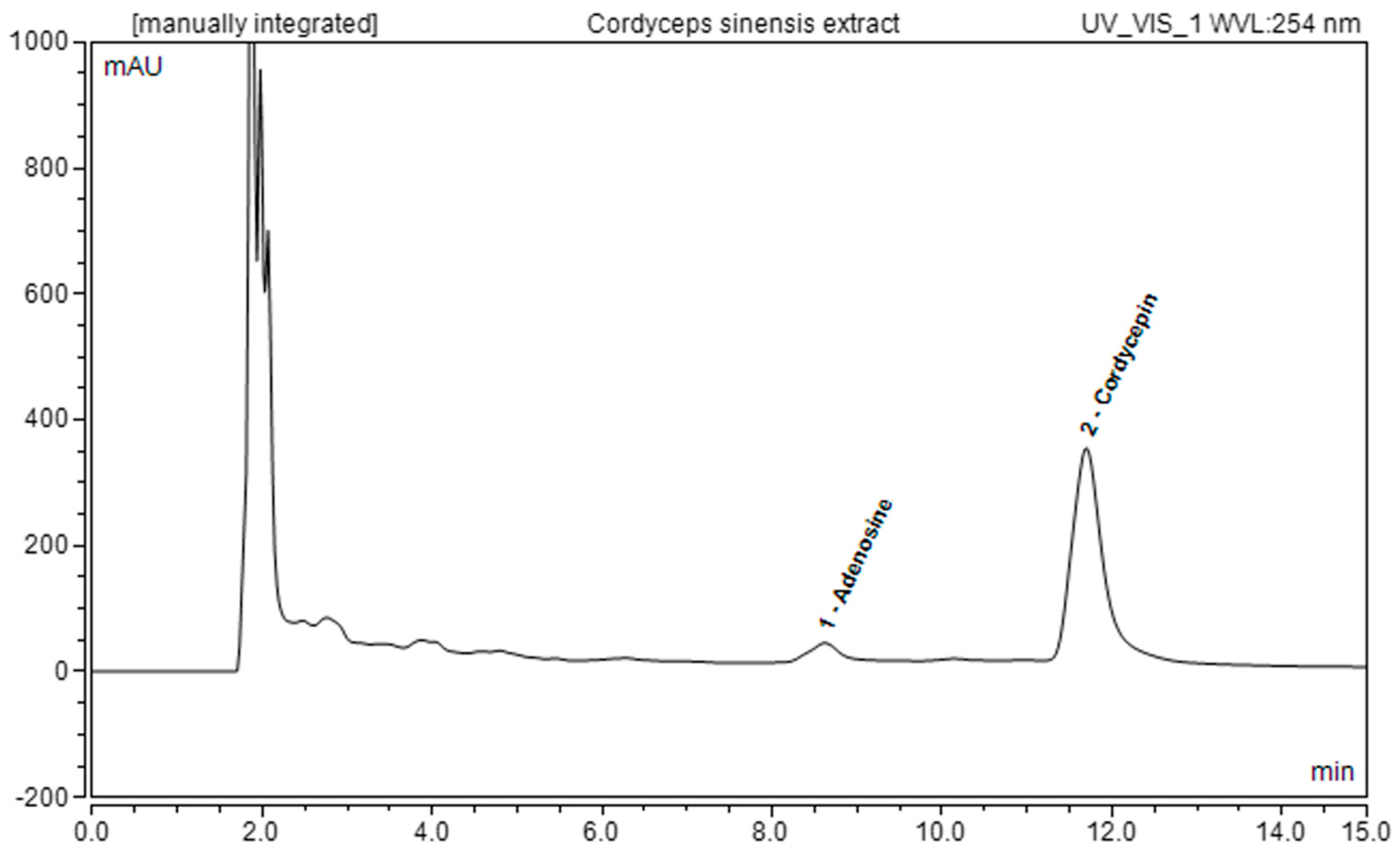
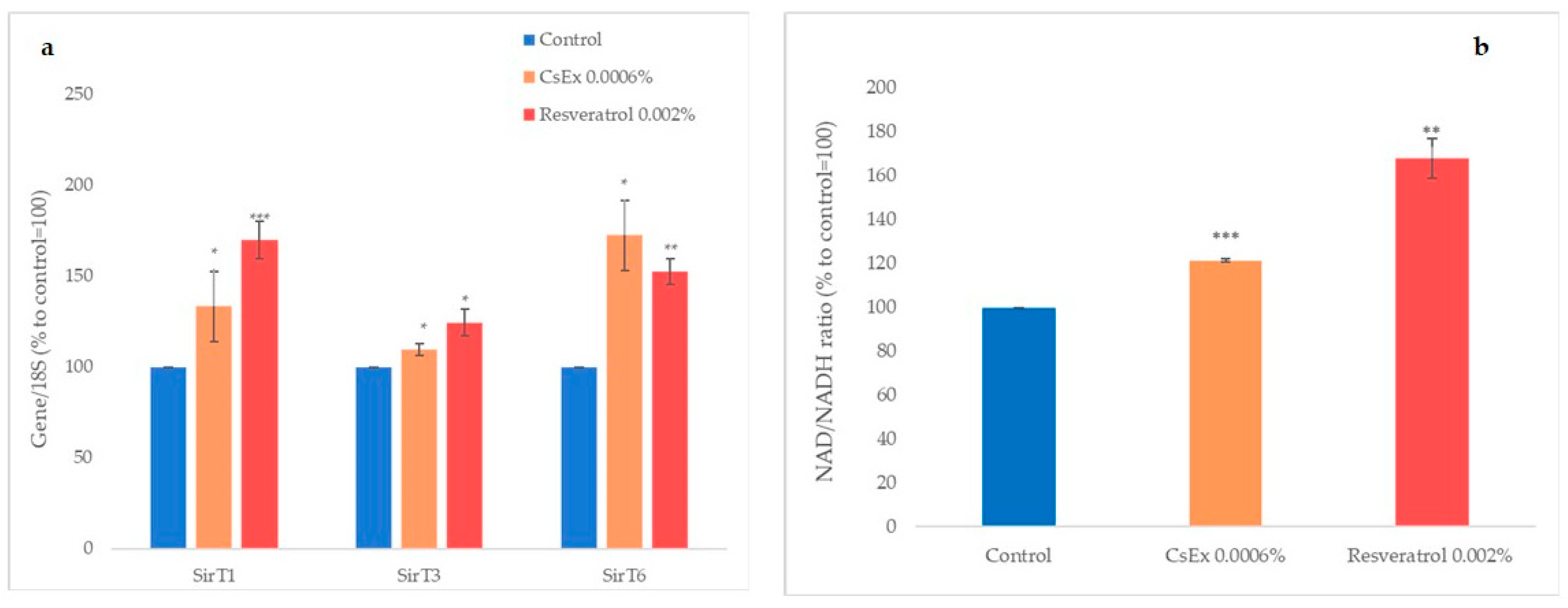



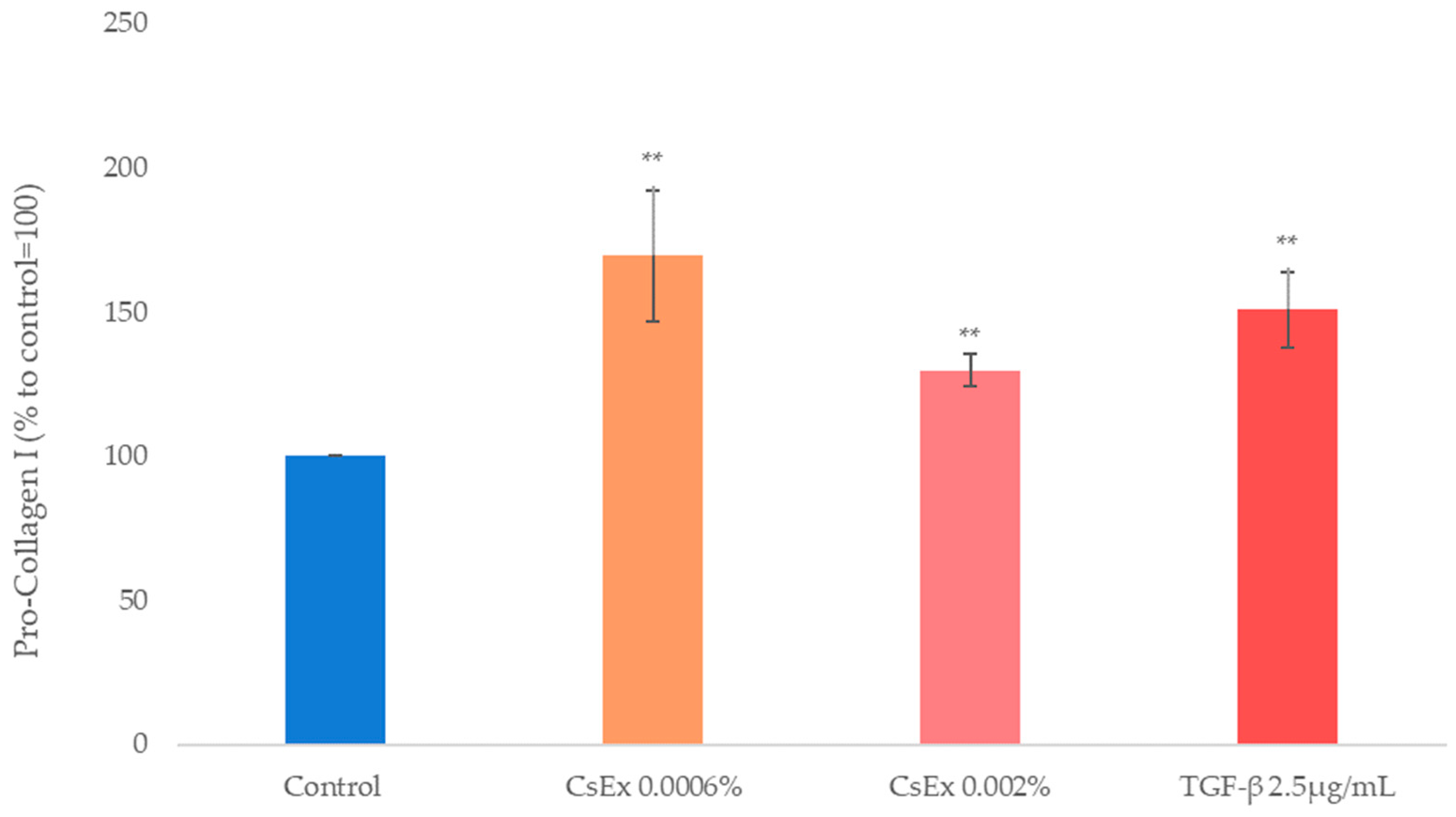
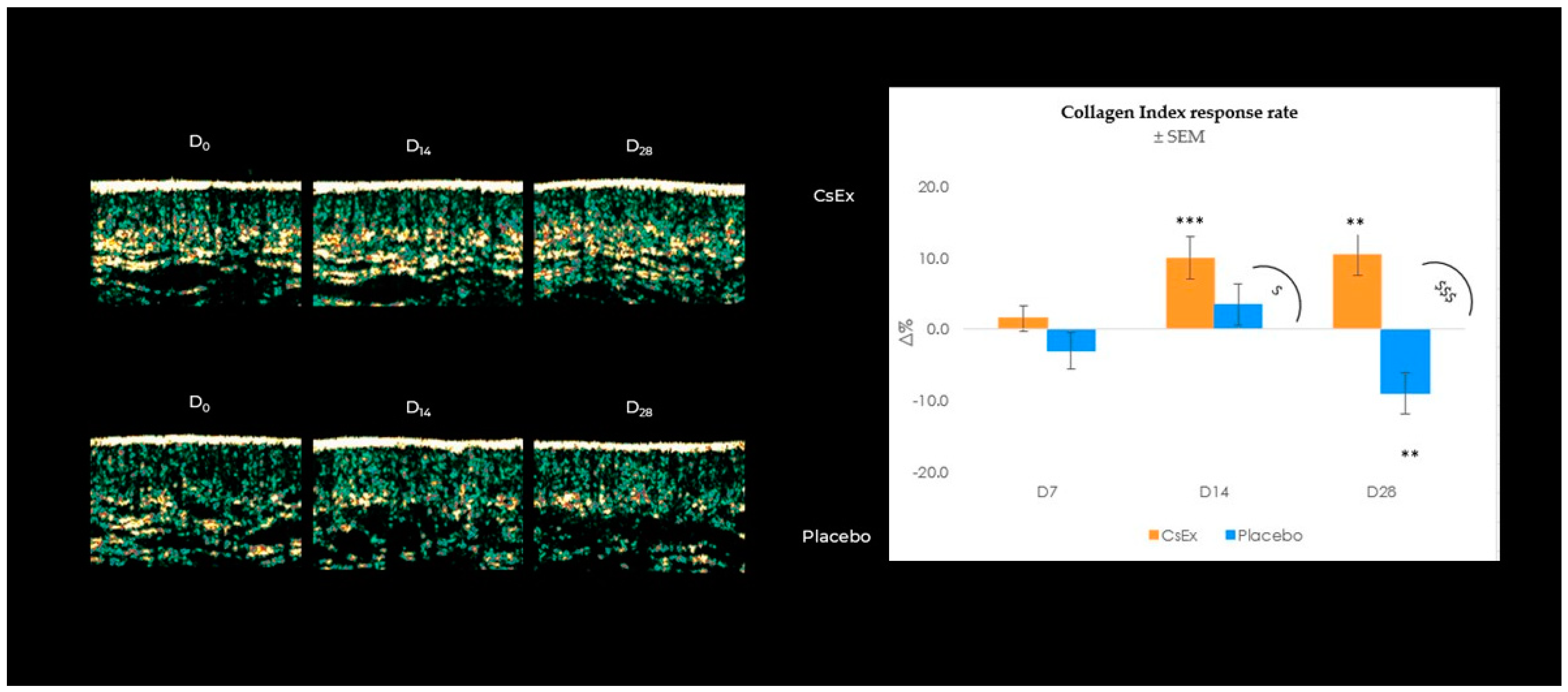
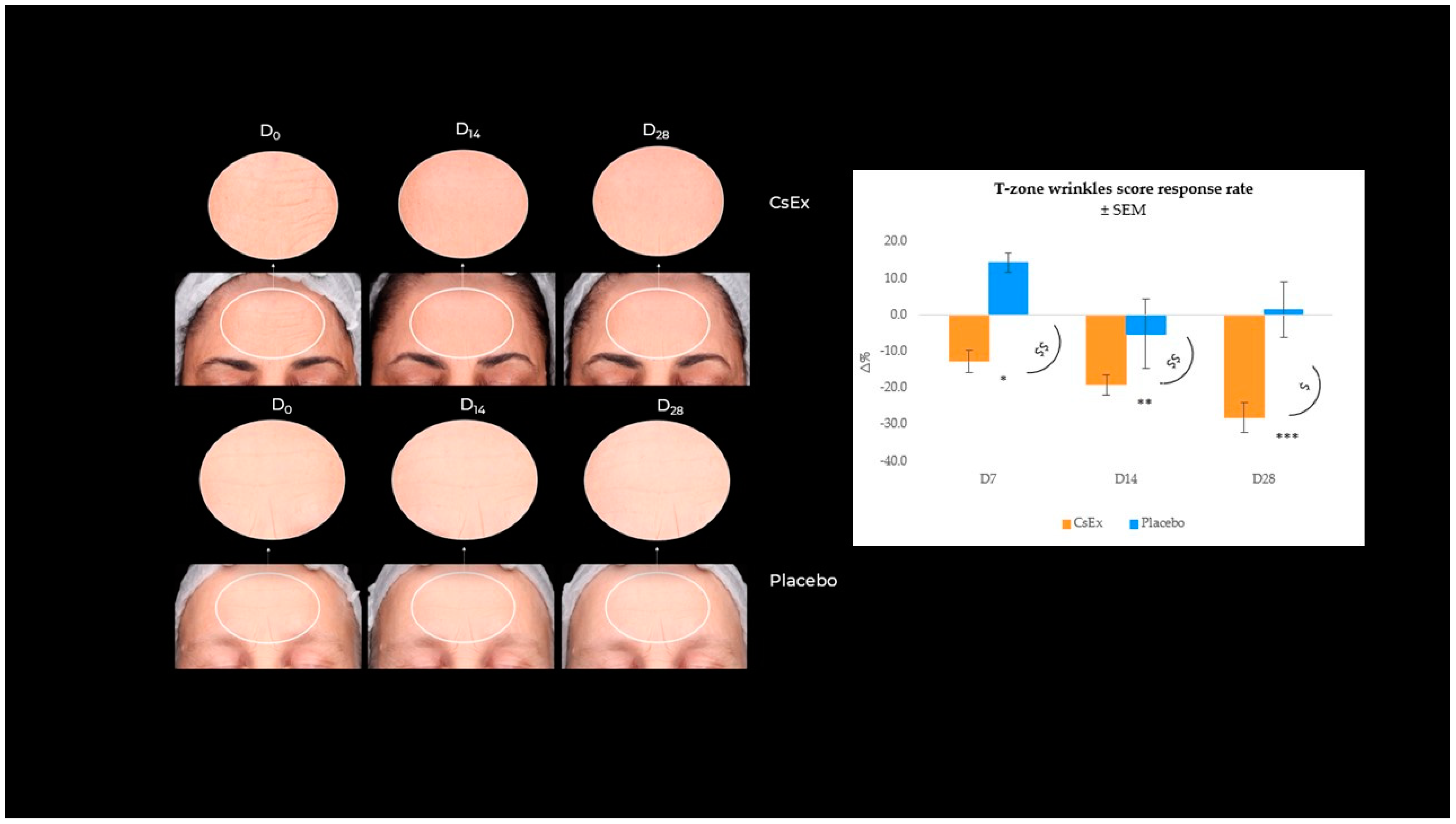
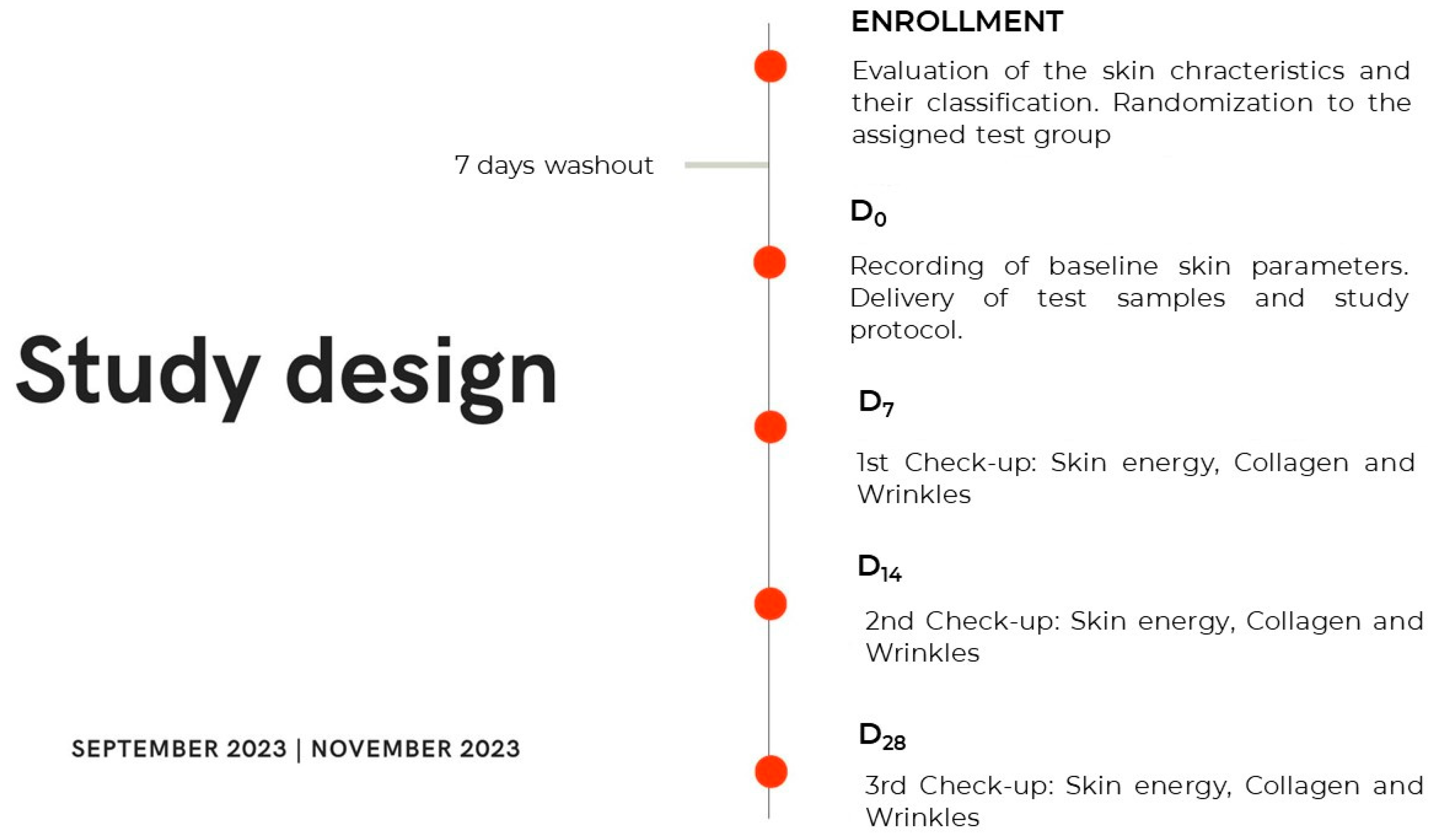
| Identified Compound | Quantified Amount in Hydroethanolic Extract (µg/g Freeze-Dried Sample) |
|---|---|
| Cordycepin | 6247 ± 20 |
| Adenosine | 470 ± 55 |
| Sample | Total Polyphenols (mg Gallic Acid equiv./g of Freeze-Dried Extract) | Total Protein (mg BSA equiv./g of Freeze-Dried Extract) | Total Peptides (mg L-Serine equiv./g of Freeze-Dried Extract) | Glucose (mg/g of Freeze-Dried Extract) | Fructose (mg/g of Freeze-Dried Extract) | Sucrose (mg/g of Freeze-Dried Extract) |
|---|---|---|---|---|---|---|
| C. sinensis hydro-ethanolic extract | 21.2 ± 0.4 | 23.6 ± 0.1 | 9.4 ± 0.4 | 15.9 ± 0.8 | 4.7 ± 0.2 | 1.4 ± 0.1 |
| Characteristics of Study Participants | CsEx | Placebo |
|---|---|---|
| No. of subjects | ||
| Female, n (%) | 20 (100) | 20 (100) |
| Male, n (%) | - | - |
| Mean age ± SD a, years | ||
| (min–max) | 47.5 ± 6.3 (41–62) | 49.1 ± 7.2 (42–65) |
| Fitzpatrick skin phototype, n (%) | ||
| I | 2 (10) | 1 (5) |
| II | 15 (75) | 16 (80) |
| III | 3 (15) | 3 (25) |
| IV | - | - |
| Signs of aging, n (%) | ||
| Wrinkles | 20 (100) | 20 (100) |
| Hyperpigmentation | 5 (25) | 3 (15) |
| Skin laxity | 10 (50) | 8 (40) |
| Dermis thinning | 12 (60) | 10 (50) |
Disclaimer/Publisher’s Note: The statements, opinions and data contained in all publications are solely those of the individual author(s) and contributor(s) and not of MDPI and/or the editor(s). MDPI and/or the editor(s) disclaim responsibility for any injury to people or property resulting from any ideas, methods, instructions or products referred to in the content. |
© 2024 by the authors. Licensee MDPI, Basel, Switzerland. This article is an open access article distributed under the terms and conditions of the Creative Commons Attribution (CC BY) license (https://creativecommons.org/licenses/by/4.0/).
Share and Cite
Di Lorenzo, R.; Falanga, D.; Ricci, L.; Colantuono, A.; Greco, G.; Angelillo, M.; Nugnes, F.; Di Serio, T.; Costa, D.; Tito, A.; et al. NAD-Driven Sirtuin Activation by Cordyceps sinensis Extract: Exploring the Adaptogenic Potential to Promote Skin Longevity. Int. J. Mol. Sci. 2024, 25, 4282. https://doi.org/10.3390/ijms25084282
Di Lorenzo R, Falanga D, Ricci L, Colantuono A, Greco G, Angelillo M, Nugnes F, Di Serio T, Costa D, Tito A, et al. NAD-Driven Sirtuin Activation by Cordyceps sinensis Extract: Exploring the Adaptogenic Potential to Promote Skin Longevity. International Journal of Molecular Sciences. 2024; 25(8):4282. https://doi.org/10.3390/ijms25084282
Chicago/Turabian StyleDi Lorenzo, Ritamaria, Danila Falanga, Lucia Ricci, Antonio Colantuono, Giovanni Greco, Maura Angelillo, Fiorella Nugnes, Teresa Di Serio, Dorothea Costa, Annalisa Tito, and et al. 2024. "NAD-Driven Sirtuin Activation by Cordyceps sinensis Extract: Exploring the Adaptogenic Potential to Promote Skin Longevity" International Journal of Molecular Sciences 25, no. 8: 4282. https://doi.org/10.3390/ijms25084282
APA StyleDi Lorenzo, R., Falanga, D., Ricci, L., Colantuono, A., Greco, G., Angelillo, M., Nugnes, F., Di Serio, T., Costa, D., Tito, A., & Laneri, S. (2024). NAD-Driven Sirtuin Activation by Cordyceps sinensis Extract: Exploring the Adaptogenic Potential to Promote Skin Longevity. International Journal of Molecular Sciences, 25(8), 4282. https://doi.org/10.3390/ijms25084282








